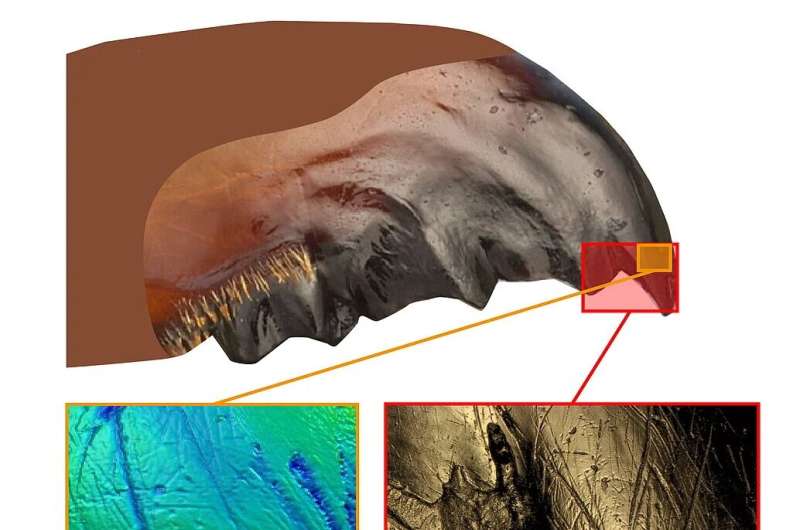This article has been reviewed according to Science X's editorial process and policies. Editors have highlighted the following attributes while ensuring the content's credibility:
fact-checked
trusted source
proofread
Study shows insect diet is reflected by the wear and tear on their jaws

Show me your jaw and I'll tell you what you eat: This could be the motto of a study conducted at Kiel University (CAU) and the University of Tokyo. The researchers investigated whether the wear and tear on insect mouthparts can be used to determine their eating habits.
This type of analysis has been standard for vertebrates for decades because scientists can gain far-reaching insights into the living conditions of the species studied from the results. In the case of vertebrates, this is particularly interesting for fossil finds: A look at the teeth reveals a lot about the ecological niche in which the animal in question lived millions of years ago.
Iron deposits instead of tooth enamel
"We wanted to know whether this method could also be transferred to insects," explains Dr. Daniela Winkler from the Institute of Zoology at Kiel University. "They don't have teeth, but they do have mandibles, which they use to crush their food."
Similar to teeth, insect jaws also have a protective layer that makes them less sensitive to abrasion. This does not consist of tooth enamel, however, but of embedded metals such as zinc or iron. "We investigated what traces certain food components leave on the mandibles despite this protective layer," says Winkler.
The zoologist is an expert in dental analyses and also a pioneer in this field: A few years ago, she was the first scientist in the world to prove that the teeth of reptiles also wear out in a characteristic way depending on their diet. Her findings enable completely new insights into the ecology of dinosaurs, for example.
She and her colleagues from Japan have now also ventured in uncharted territory with insects. "We carried out experiments with crickets that we fed differently," she says. "All the animals were fed alfalfa in pellet form. However, we mixed different ingredients into this basic food, including coarse quartz sand or volcanic ash."
The study is published in the journal Interface Focus.
Mandibles wear down very similarly to guinea pig teeth
The experiment ran for a month. During this time, the researchers made several 3D surface scans of the mandibles using a special microscope. With the help of a computerized, automated evaluation method, they then measured the topography of the mandible surface—in simple terms: how rough it was.
They recorded more than 40 parameters in total, including the average depth of the furrows and the complexity of the wear patterns. One finding even surprised Winkler herself. "We previously investigated the wear of guinea pig teeth in a similar way—also using food pellets to which we had added quartz sand or ash to simulate the ingestion of such particles in their natural habitat.
"Because this actually occurs frequently in herbivores," she says. "The mandibles of crickets wear out in an almost identical way, although they are considerably smaller and their mouthparts have a completely different structure."
Reliable insight into the crickets' diet
In fact, just a few days after the start of the experiment, it was possible to tell with great certainty from the parameters how the creatures had been fed. The marks on the mandibles obviously provide reliable insight into the crickets' diet. However, the method is probably not suitable for fossilized insect finds. This is because the mandibles must be preserved in a three-dimensional form, which is rarely the case. Insects preserved in amber cannot be analyzed in this way either, as the jaws are covered by a layer of resin.
Nevertheless, the results may be of substantial interest for experts: many natural history museums around the world have large collections of insects. Some of these crickets, beetles, bugs and dragonflies are several hundred years old. Their mandibles document how their ecological niche has changed since then—through human intervention, environmental degradation, climate change or the immigration of new plant species.
"The marks also show how quickly the insects adapted to this change," explains Winkler, "whether, for example, they directly tapped into new food sources when their favorite plant became scarcer—or whether they only did so when they could no longer survive otherwise."
More information: Daniela E. Winkler et al, Mandible microwear texture analysis of crickets raised on diets of different abrasiveness reveals universality of diet-induced wear, Interface Focus (2024). DOI: 10.1098/rsfs.2023.0065
Provided by Kiel University

















